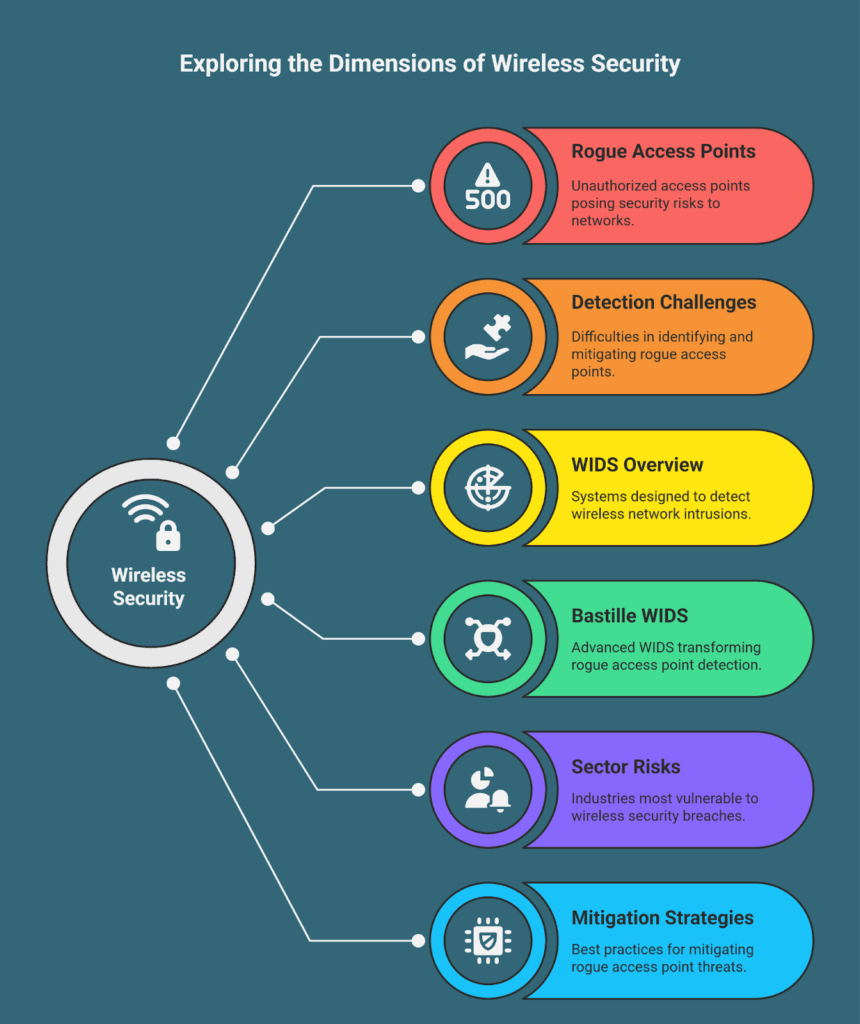The Expanding Wireless Threat Landscape
Rogue Wireless Access Point Detection has become a critical focus in enterprise cybersecurity as wireless connectivity is now the foundation of operations. From laptops and smartphones to Bluetooth peripherals, IoT sensors, and cellular-connected devices, nearly every organization relies on wireless communication to function. This dependence has dramatically expanded the wireless attack surface.
The risks are not hypothetical. A single unauthorized device costing less than thirty dollars can provide malicious actors with a covert entry point into an enterprise environment. Traditional perimeter defenses, such as firewalls and wired intrusion detection systems, cannot monitor the airspace. This gap leaves enterprises vulnerable to invisible threats operating in the radio frequency spectrum.
Among the most dangerous of these risks is the rogue wireless access point (AP). These unauthorized devices can undermine even the most advanced cybersecurity architectures by bypassing monitoring and blocking controls. Effective detection and mitigation of rogue access points requires security teams to monitor Wi-Fi for unauthorized devices. Modern wireless intrusion detection systems (WIDS) provide this visibility.
What Is a Rogue Wireless Access Point?
A rogue wireless access point is any Wi-Fi device that connects to an enterprise network without explicit authorization. Rogue APs may be:
- Maliciously deployed by attackers attempting to infiltrate the network
- Accidentally installed by employees or contractors using personal devices
- Introduced through shadow IT practices that bypass formal approval processes
Regardless of intent, these devices compromise wireless security by extending an organization’s airspace to unauthorized connections. Effective Rogue Wireless Access Point Detection helps identify and mitigate these risks before adversaries can exploit them.
Why Rogue Access Points Are Dangerous
The threat from rogue access points is serious because once operational, they enable a wide range of wireless-based attacks. Common attack scenarios include:
Eavesdropping on Communications
Rogue APs allow attackers to intercept sensitive data transmitted across unencrypted or poorly secured wireless sessions. This data may include intellectual property, financial records, or personal data.
Man-in-the-Middle Attacks
By masquerading as a legitimate access point, a rogue device can trick users into connecting. Once connected, attackers can intercept, alter, or redirect traffic, enabling surveillance and data manipulation.
Data Exfiltration
A rogue AP can provide attackers with a direct pathway to siphon data from enterprise systems. Because the traffic flows outside traditional monitoring systems, data theft often goes undetected.
Credential Harvesting
Attackers can configure rogue APs to mimic trusted networks. Unsuspecting users who attempt to log in inadvertently submit their credentials, which attackers then harvest for broader compromise.
Network Reconnaissance
By maintaining a foothold inside enterprise airspace, rogue APs allow adversaries to map internal networks, identify valuable systems, and plan future attacks.
Beyond technical risk, rogue access points also represent a compliance threat. Frameworks such as PCI DSS, HIPAA, and GDPR require organizations to secure wireless environments. The presence of unauthorized devices may result in fines, failed audits, and reputational damage.

The Evolution of Wireless Enterprise Security
Early enterprise security strategies focused primarily on the wired perimeter. Firewalls and network access control were effective when most communication occurred through physical infrastructure.
As Wi-Fi became essential, organizations adopted encryption and authentication to secure it. However, Attackers have adapted their tactics, attacking vulnerabilities in the security protocol or its implementation, or moved to different protocols, exploiting Bluetooth connections, IoT vulnerabilities, and cellular bypasses to access networks.
Legacy WIDS solutions are limited to Wi-Fi-only monitoring, and while they can detect rogue access points, their ability to secure the growing wireless attack surface is limited. Some solutions added basic Bluetooth visibility but lacked more advanced features such as paired device tracking, localization, or coverage for other wireless protocols. Bastille advanced the category further by extending monitoring to Cellular and IoT protocols, redefining what WIDS can achieve.
Key Challenges in Rogue Wireless Access Point Detection
Identifying rogue APs is not a straightforward process. Enterprises encounter several obstacles:
Lack of Visibility in Traditional Security Tools
Firewalls, IDS, and NAC typically monitor wired traffic. They cannot inspect wireless signals, leaving airspace activity unmonitored.
Constantly Changing RF Environments
Wireless networks are dynamic. Devices connect and disconnect throughout the day, and attackers can deploy temporary access points that disappear before manual checks detect them.
Ineffectiveness of Manual Surveys
Some organizations still rely on site surveys to identify rogue APs. These only provide snapshots in time and cannot account for transient or low-power devices.
Shadow IT Growth
Employees often introduce personal devices that connect to corporate networks, mistakenly believing this will “improve” Wi-Fi access reception in the area with no detrimental effects to security, complicating the task of distinguishing between legitimate and unauthorized connections.
Advanced Adversarial Tactics
Attackers increasingly use deceptive strategies such as evil twin attacks, where a rogue AP mimics a trusted SSID. Others deploy mobile or low-power devices that evade traditional scanning methods.
Enterprises require real-time, automated, multi-protocol monitoring to overcome these challenges.
Wireless Intrusion Detection Systems: An Overview
A Wireless Intrusion Detection System (WIDS) continuously monitors enterprise airspace to detect unauthorized activity across the entire RF spectrum. Effective WIDS solutions provide:
- Multi-protocol coverage: Wi-Fi, Bluetooth, Cellular, and IoT
- Device classification: Differentiation between authorized and unauthorized devices
- Anomaly detection: Machine learning to identify unusual or suspicious behavior
- Threat localization: Real-time location data to guide physical takedowns
- Actionable intelligence: Alerts that empower incident responders
WIDS closes the visibility gap left by traditional defenses, acting as the persistent surveillance system for enterprise airspace.
How Bastille’s WIDS Transforms Rogue Access Point Detection
Bastille Networks delivers a modern WIDS solution built for enterprises with complex wireless environments, offering advanced Rogue Wireless Access Point Detection among its key differentiators:
Comprehensive RF Spectrum Coverage
Bastille scans the full spectrum between 25 MHz and 7.125 GHz, eliminating blind spots across every wireless protocol.
Precise Threat Localization
Bastille pinpoints rogue devices at desk-level accuracy, enabling incident responders to remove unauthorized equipment physically.
AI-Powered Analysis
Machine learning algorithms reduce false positives and assign context-aware risk scores. Security teams can focus on the most significant threats.
Compliance and Audit Reporting
The system automatically generates tamper-proof logs documenting threats, device movements, and response actions. These records support regulatory audits and internal reviews.
Seamless Security Stack Integration
Bastille integrates directly with SIEM, SOAR, and XDR platforms. Security teams can correlate wireless threats with other events, creating a unified defense strategy.
By contrast, legacy WIDS solutions from Cisco and Aruba remain Wi-Fi-only. They cannot detect threats across Bluetooth, Cellular, or IoT protocols. Bastille redefines WIDS by delivering complete, multi-protocol visibility.
Best Practices for Rogue Access Point Mitigation
An effective strategy against rogue APs requires multiple layers of defense. Recommended best practices include:
- Deploy Continuous Multi-Protocol Monitoring
WIDS should operate 24/7, continuously scanning all wireless frequencies. - Automate Detection and Alerting
Automated alerts allow security teams to act quickly when the WIDS identifies rogue devices. - Perform Device Localization and Validation
Precise localization enables rapid physical identification and removal of unauthorized devices. - Educate Employees on Wireless Risks
Organizations should implement clear policies discouraging personal wireless equipment. Training helps reduce accidental introduction of rogue devices. - Conduct Regular Wireless Vulnerability Assessments
Pair continuous monitoring with penetration testing and configuration reviews to strengthen defenses. - Integrate WIDS Data into SOC Workflows
WIDS findings should feed directly into SIEM and SOAR platforms to accelerate incident response.
Comparison: Traditional Security Tools vs Bastille WIDS
| Capability | Wired IDS/NAC | Manual Surveys | Bastille WIDS |
| Wireless Coverage | None | Limited snapshot | Comprehensive across Wi-Fi, Bluetooth, Cellular, IoT |
| Continuous Monitoring | No | No | Real-time 24/7 |
| Automated Alerting | Limited | No | Yes |
| Threat Localization | N/A | Approximate | Desk-level precision |
| Multi-Protocol Detection | No | Wi-Fi only | Full spectrum (25 MHz–6 GHz) |
| AI/ML Analysis | No | No | Advanced risk scoring |
| SIEM/SOAR Integration | Partial | No | Full integration |
| Audit Reporting | Manual | Manual | Automated, tamper-proof |
Real-World Applications: Sectors at Risk
Some industries face greater consequences from rogue APs:
- Government and Defense: Protection against espionage and insider threats
- Financial Services: Preventing fraud and safeguarding compliance
- Healthcare: Securing patient data and meeting HIPAA requirements
- Energy and Critical Infrastructure: Protecting SCADA and OT environments
- Technology Enterprises: Reducing risks of intellectual property theft
Integrating WIDS with Broader Security Controls
WIDS should not function in isolation. Its effectiveness increases when aligned with enterprise-wide defenses:
- SIEM Integration: Centralizing wireless alerts with other logs
- SOAR Integration: Automating response workflows for faster remediation
- XDR Correlation: Linking wireless events with endpoint and cloud data
- Zero Trust Security: Applying continuous verification to the wireless spectrum
This integration detects and mitigates rogue APs as part of the enterprise’s overall security architecture.
FAQ: Rogue Wireless Access Point Detection
What is the fastest way to detect rogue APs?
A WIDS provides continuous spectrum monitoring, identifying unauthorized devices in real time without disrupting normal operations.
Can firewalls or NAC provide Rogue Wireless Access Point Detection?
No. Firewalls and NAC are limited to monitoring wired traffic and cannot identify unauthorized wireless signals.
What is an evil twin?
An evil twin is a rogue AP configured to mimic a legitimate SSID. Users connect without realizing the deception, enabling attackers to intercept data.
How does Bastille’s WIDS outperform other solutions?
It offers full-spectrum monitoring, AI-driven threat analysis, desk-level localization, and seamless SIEM/SOAR integration.
How should enterprises respond to a rogue AP?
Disconnect the device, isolate affected systems, investigate exposure, and update security policies to prevent recurrence.
How does WIDS fit into Zero Trust?
Zero Trust assumes that the network trusts no device by default. WIDS enforces this principle by continuously validating all wireless communications.
Proactive Wireless Security for the Modern Enterprise
Rogue access points are a critical security concern. They exploit gaps in traditional defenses, creating opportunities for data theft, espionage, and compliance failures, which makes effective Rogue Wireless Access Point Detection essential for enterprise protection. However, there are more threats to the wireless attack surface than Wi-Fi, and a modern WIDS solution should handle Rogue access point detection and threats from other protocols for more security coverage.
Legacy Wi-Fi-only monitoring cannot protect today’s enterprises. While this may be sufficient for rogue access point detection, Bastille’s multi-protocol WIDS extends visibility across Wi-Fi, Bluetooth, Cellular, and IoT protocols for better security. With real-time detection, precise localization, and seamless integration with broader security stacks, Bastille enables security teams and incident responders to maintain control over the enterprise wireless attack surface.
Organizations that deploy Bastille’s WIDS strengthen resilience against modern wireless threats and align with the principles of Zero Trust security.
Learn more about Bastille’s wireless intrusion detection system solution and request a demonstration today.



